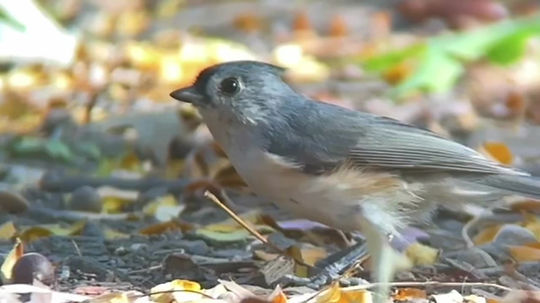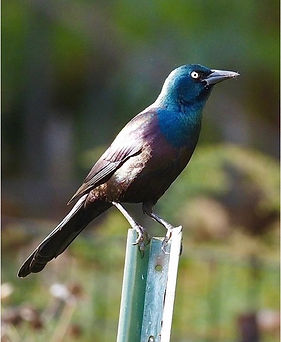
What’s in Flight
Fall/Winter 2024
Don’t be fooled by the quiet in Winter. There are more birds in our park now than in the summer, and some of the most charming, acrobatic, small birds over winter here. Naturalist Gabriel Willow estimates that while around 20 bird species breed here in summer, there are 30 species in winter.
Two of the cutest and most vocal birds in our park this time of year are the Winter Wren and the Carolina Wren. The Winter Wren has a rotund little speckly brown body and holds it’s tail straight up. It has a loud voice and sings with ‘a cascade of bubbling notes’ (the Cornell Lab of Ornithology’s official description), and mostly hops and scampers on the ground, as it is a weak flyer.

Winter Wren by Brad Balliett
To keep warm during the cold winter months, the tiny cinnamon-colored Carolina Wren sometimes roosts in hornets’ nests or makes a home in a flowerpot. This one was checking out a hornets’ nest in a tree near the Peter Pan statue. These plump little birds love to sing. One male was recorded singing nearly 3,000 times in one day.

Carolina Wren checking out a Hornets’ nest by Jay Zemann
Considered one of the cutest and smartest Northeastern small birds, the Black-capped Chickadee can store up to a thousand seeds in a day and remember all the locations! Chickadees are often the ring leaders of bird flocks that can include other species such as Nuthatches, Kinglets and Titmice. ‘Diverse groups of birds are better at fending off predators, and problem solving,’ reports Todd M Freeberg, an animal behaviorist at the University of Tennessee.

Black-capped Chickadee by Jay Zemann
Tufted Titmice with their blue-grey feathery ‘mohawk’ (in birding parlance ‘a crest’), big black eyes, and fondness for eating seeds out of your hand, are also heart stealers. They are close relatives of Black-capped Chickadees, and like Chickadees and Nuthatches tend to appear in large numbers in winter in our park, but only when the seed supply from birches and pines in their rural habitat fails. We expect all three species to be regulars on our bird feeders by the Catbird Playground and Gracie Mansion this winter.

Tufted Titmouse by Brad Balliett
Red-breasted Nuthatch are incredible acrobats. They can walk up and down trees and hang upside down with ease. This gravity defying behavior is possible due to their sharp claws and long hind toe.

Red-breasted Nuthatch by Jay Zemann
A year round resident of the park, is the elegant American Song Sparrow. It has a streaky breast and russet striped crown on its head. It sings a short trilling song and is often found in shrubs or close to the ground. This one was found singing in a popular birding spot, the North Field (close to the ferry terminal).

Song Sparrow by Jay Zemann
One of the hardiest birds to overwinter in our park is the tiniest. The Golden-crowned Kinglet is about the weight of a nickel and the length of your thumb, but it can endure nighttime temperatures of -40F. University of Vermont scientist Bernd Heinrich discovered that these kinglets subsist in winter on moth caterpillars found over-wintering in the trees. This food source alone isn’t sufficient to keep them warm through the night. The key is their ability to fluff up their feathers to make an inch-thick, downy blanket. Also, they sleep in small huddles with other birds.

Golden-crowned Kinglet by Jay Zemann
Brad Balliett, an experienced bird photographer captured this little Ruby-crowned Kinglet floofing. Birds often shake and fluff up their feathers in winter to stay warm and trap warm air against their skin. But ‘floofing’ can also be when they are getting ready to sleep, to shake off debris or water, or the start of a preening routine. And sometimes, floofing just indicates happiness.

Ruby-crowned Kinglet floofing by Brad Balliett
One of the most beautiful but oft overlooked large birds in our park is the Common Grackle. These large blackbirds have glossy iridescent blue, green or purple heads, and bronze colored bodies. They strut on long legs around the lawns and roost in large communal flocks with other species of blackbird. Flocks can number in the millions.

Common Grackle by Jay Zemann
The majority of American Robins migrate out of the Park in the fall, but a few over winter here. Robins depend on fruit in the winter, says ornithologist David Allen Sibley. ’The recent spread of invasive berry-producing plants (like bittersweet and buckthorn) means that robins can find winter food much further north.’ In summer, they prefer to pluck a juicy earthworm out of the ground.

American Robin by Jay Zemann
Mute Swans, the elegant all white bird of European fairy tales can be glimpsed occasionally year round gliding on the East River. This swan swims with its long neck curved into an 'S' and often holds its wings raised slightly above its back. All of the Mute Swans in North America are descendants of the swans imported from Europe in the mid 1800s through early 1900s. Mute Swans have enormous appetites and can eat up to eight pounds of aquatic vegetation a day. They are also extremely aggressive, so keep well clear.

Mute Swans by Jay Zemann
Cedar Waxwings are extremely social birds and travel in flocks hunting widely for fruit. These colorful birds, (their red wing tips and yellow tail colors are a product of the carotenoid compounds in the fruit and seeds they eat) have been spotted flashing through our park almost every month year round. Photographer Jay Zemann recently saw an ‘ear-full’ (the birding term for a waxwing flock) feasting on a crab apple tree in the North Field (just north of Gracie Mansion).

Cedar Waxwing by Jay Zemann
The number of bird species spotted in our park recently jumped from 155 to 161 (for comparison that’s more than half the 273 species that have been spotted in Central Park). A thrilling addition to the list this fall was a super rare Connecticut Warbler, spotted by Jay Zemann. It was hanging out in an Ailanthus tree, next to the esplanade. Gabriel Willow, who leads bird walks all over New York, said: ‘I've never seen an adult Connecticut Warbler in Manhattan and ironically its almost unheard of in Connecticut. Adult Connecticut Warblers typically migrate up the Central Flyway (over the mid-west) to breeding grounds in and around the lakes and Canada.’ Our bird was a juvenile. Gabriel says: ‘I’ll typically see one juvenile Connecticut Warbler in the city each year. For some reason, in the fall, the juveniles sometimes take the Atlantic Flyway (which crosses Manhattan) to their wintering grounds in Bolivia, Peru and Paraguay.’
Connecticut Warbler by Jay Zemann
Words: Lucie Young
Videos: Brad Balliett – X (formerly Twitter) @BalliettBrad
Images: Jay Zemann
Check out our previous edition of What's in Flight


